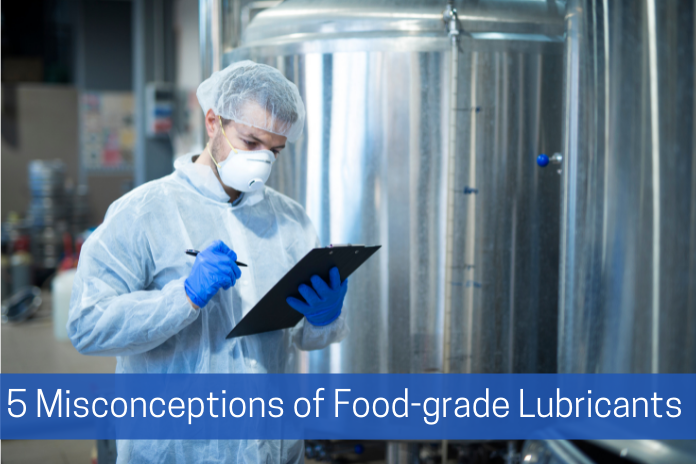Food Grade Lubricants are incidental food contact lubricants and greases that keep processing equipment functioning and also manage apprehensions concerning chemical hazards. Nonetheless, some food and beverage companies doubt the products’ capability to satisfy their production needs regardless of any solid evidence regarding this. Yet, misconceptions surround Food Grade Lubricants, which we will reveal here.
Misconception #1: Food Grade Lubricant Options Are Limited
As of now, there are over 12000 H1-registered lubricants developed for different applications, machine parts and equipment types. For instance, some FGLs can work in temperatures as low as -46 degrees Celsius and as high as 163 degrees Celsius. Furthermore, there are FGLs with anti-microbial properties or fire resistance. Typically, substances accepted as safe status are regarded as suitable.
Makers are continuously innovating and investing in chemical technologies outside the conventional realm of 21 CFR. A lubricant manufacturer or ingredients supplier can submit a Food Contact Notification (FCN) to the FDA for all unregulated food contact substances. Once FDA approves, the manufacturer can use the ingredient. As an option to FCNs, a lubricant manufacturer can apply for a Threshold of Regulation (TOR) exclusion from the FDA.
Misconception #2: If You Use FGLs Anywhere, You Have to Use Them Everywhere
Food Grade and Industrial Lubricants should not mix, but you can use them separately at the same food or beverage processing facility. Only use FGLs in the processing area above the production line, which carries out activities like blending, slicing, cutting, canning or handling. Conversely, there should not be any contact between Industrial Grade Lubricants and Food. Industrial-grade products are used only below the production line within closed equipment systems and in places where contact with food is not possible.
If doubts about using the type of lubricant, defer to the Food-Grade option. Read product labels cautiously before every use to help eradicate the risk of cross-contamination. Industrial Grade products are registered as the H2 category of lubricants. You should not mix H2-tagged products with H1 or ISO 21469-certified products.
Misconception #3: Food Grade Means It Is Also Free from Allergen
The aim is to determine if incidental contact with food is acceptable. H1 registration and ISO 21469 certification requirements direct that lubricants should comply with the regulatory guidelines and should not contain mutagens, carcinogens, teratogens, mineral acids or deliberately added heavy metals. Allergens aren’t considered, and they do not verify if the lubricant is manufactured according to Kosher and Halal criteria. Food Grade does not imply a product is a food ingredient. Thus, Allergen-Free, Kosher and Halal labels are officially handled by distinct certification schemes.
Misconception #4: Food Grade Lubricants Are Edible
This misconception invokes images of cooking oils, compelling us to think FGLs are somewhat a lesser product in terms of industrial performance. The phrase Food Grade does not refer to edibility but refers to Food Safety. Aim for zero contact when using lubricants in food or beverage processing facilities. Food Grade Lubricants are required to avert severe problems in minor contact with the food, known as incidental contact. If such contact does happen, there is a 10 parts-per-million (ppm) limit for lubricant base oils that can be present. If the amount exceeds 10ppm, then those food items that have been compromised need to be rejected.
Misconception #5: Food Grade Lubricants Are Not as Competent as Industrial-Grade Lubricants
Nowadays, food-grade lubricants can withstand friction, corrosion, oxidation, extreme temperatures, harsh conditions and heavy wash downs similar to their industrial-grade counterparts. New additives, thickeners and base oils are now available to lubricant manufacturers that have bridged the performance gap. Besides, a better understanding of lubricant chemistry has allowed developers to create products with firmer, robust molecular structures.
Is There Any Difference Between H1-Registered and ISO 21469-Certified Lubricants?
Both H1-Registered lubricants and ISO 21469-Certified Lubricants are recognised worldwide by auditors and regulators as food-grade products.
- H1-Registered Lubricants are only for food and beverage processing units.
- ISO 21469-Certified Lubricants are also accepted by the cosmetics, pharmaceutical, tobacco and animal feed industries.
Whether to use H1-Registered or ISO 21469-Certified Lubricants depends on the food or beverage company standards for food safety.
The Bottom Line
Food Grade Lubricants are not edible but facilitate incidental contact with food. Simultaneously, FGL is a high-performance product that can help food and beverage processors on their way to GFSI (Global Food Safety Initiative) certifications. H1-Registered and ISO 21469-Certified Lubricants aren’t limited in their varieties, and when used as desired, they do not exhibit a health hazard. Using an FGL facilitates food and beverage companies to strike a balance between production demands and food safety.











